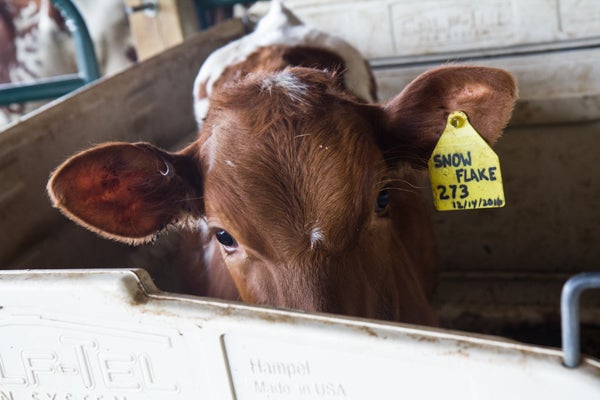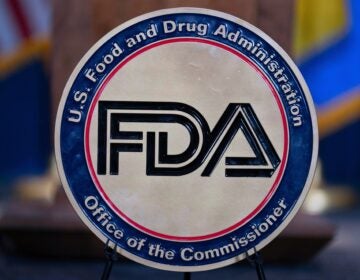In the meat industry, cellular agriculture is a new frontier
Listen 7:27
Rebecca Ruth Seidel with her dairy cows. (Kimberly Paynter/WHYY)
Scientists are creating meat without killing animals.
Some people sink their teeth into a piece of juicy, bloody steak and enjoy every bite. Others take a nibble — think about the cow or the greenhouse gases required for livestock production — and they feel a little guilty. Contemplating dinner can give you indigestion, but science may change how we think about dairy and meat production.
The Memphis Meats company produces meat without slaughtering animals.
“We’re making living cells turn into muscle tissue that we then can eat, which is what meat is, muscles,” said Eric Schulze, a senior scientist with the company.
The process starts with cells, a biopsy from high-quality animals, he says.
“We can grow them in these large vats, if you will, like you would find at a brewery,” Schulze said. “We feed them sugars, fats, vitamins, minerals the same things that you need to grow. These cells then can use that energy to produce and turn themselves into muscle and then that can be processed into this, you know, similar cuts of meat and products that you buy at the grocery store right now.”
The company has produced chicken meat and duck meat by growing cells, Schulze says.
Memphis Meats chicken tastes just like meat you’d buy in the store, because it is fundamentally the same thing, Schulze says. At the company they call it “clean meat.”
The products aren’t on the market yet. And if they were, they’d likely be too expensive to be profitable. The company’s clean meat costs about $6,000 a pound to produce.
Schulze says “farming” from animal cells has advantages.
“In conventional farming, you have to grow everything else that’s attached to the muscle — the cow itself, right? The bones, the brains. And has to maintain that and grow and grow and grow until it’s slaughtered,” he said. “We have to produce muscle. That’s it.”
So what do conventional farmers think about this new meat frontier?
Rebecca Ruth Seidel, a cheesemaker and dairy manager in eastern Pennsylvania’s Berks County, is open to the idea.
Memphis Meats says its process requires a fraction of the land and water that’s currently used to raise and slaughter cows, chickens, and pigs each year. Seidel says if people buy into this new way of producing meat, that could have a big environmental impact.
At Wholesome Dairy Farms, Seidel continues to bring food to people in the traditional way: There’s the farmer, the animals, and the soil.
In a navy blue coverall and boots smudged with dirt, she stands in a grassy pasture with a few of her brown-and-white speckled cows, the animals keep their gaze on Seidel as she tears apart an orange and offers them pieces.
A fourth-generation dairy farmer, Seidel is used to the hard work farming requires and unfazed by a swift torrent of cow pee that stopped this reporter in her tracks.
“My great grandfather had cows, my grandfather had cows, my father had cows,” she said. Now, she has cows. “It’s our life. It’s our way of life.”

One of Rebecca Ruth Seidel’s dairy cows named Snow Flake. (Kimberly Paynter/WHYY)
As companies push science to create not just meat but also milk and eggs, there’s strong resistance from some in the traditional farming community. But even while surrounded by living cows out breathing fresh air, Seidel envisions a future where there’s room for her and the people who make meat in labs.
“I see cellular agriculture both as a way of increasing the availability of food in a growing population and also making traditionally raised products, traditionally raised animal proteins, a niche market,” she said.
“Right now we’ve seen the effects that the organic label, the grassfed label, have had on the food market — where you can specialize and get a higher price point. I think this is just an additional level of specialization.”
So says one farmer. What do meat lovers say?
My foodie friend Marilyn D’Angelo — who was born and raised in a South Philadelphia Italian family — is a butcher’s granddaughter.
She loves all sorts of old-school meat products, including scrapple and a New Jersey orginal called pork roll.
She happily ruminates about the deliciousness of meat: “I mean, a good roast with the good fat, and it cooks all night … and what else? I mean a nice pork loin, you do a little rub.”
Depending on how it’s prepared, D’Angelo says she’d probably try meat that’s grown in a lab.
“Maybe,” she said. “It’s bizarre. It’s a whole new — I guess it’s a little weird but I would probably still eat it.”
Her raised eyebrows reflect the hesitation of lots of consumers.
Vegetarians who forgo meat to prevent animal harm might give so-called clean meat a taste because it doesn’t require animal’s death. But lots of people just haven’t thought about it much. Ask around, and on gut instinct, lots of people like D’Angelo, say it’s “weird.”
“This is not just an area where people think rationally,” said Lars Perner, a marketing professor at the University of Southern California. “You know a lot of people on an emotional level may not feel comfortable and it may take a while with the perceptions people may have that this is somehow not real food, that this is a Frankensteinian concoction.”
Perner says he’d eat it. He thinks many consumers probably have an idealized image of “traditional farming” that includes happy animals frolicking in a pasture. That’s the image we’re sold, but that’s not what most farming looks like.
“In these modern kind of factory farms, you often see very artificial conditions,” Perner said. Many cattle are raised on feedlots. “And in the U.S. many cattle are fed corn, which is really not a natural food for cows. And there have been all sorts of enhancements over time to make meat production get greater yields, so it’s already highly artificial,” he said.
So the jump to a Petri dish may not be a big leap for some consumers.
The people making meat in labs say their products could be healthier than traditional meat because it can be produced in a sterile environment, free of antibiotics and growth hormones.
Dairy farmer Seidel says change has always been part of farming. “The way we’re consuming animal proteins right now — I look at skim milk, I look at industrially processed yogurts, I look at egg patties, chicken breasts, hamburgers, all of those are constituent parts of animals that don’t necessarily need to come off a living animal,” she said.
Decades ago, Winston Churchill had a similar vision. He said we would one day “escape the absurdity of growing a whole chicken in order to eat the breast or wing, by growing these parts separately under a suitable medium.”
WHYY is your source for fact-based, in-depth journalism and information. As a nonprofit organization, we rely on financial support from readers like you. Please give today.






